








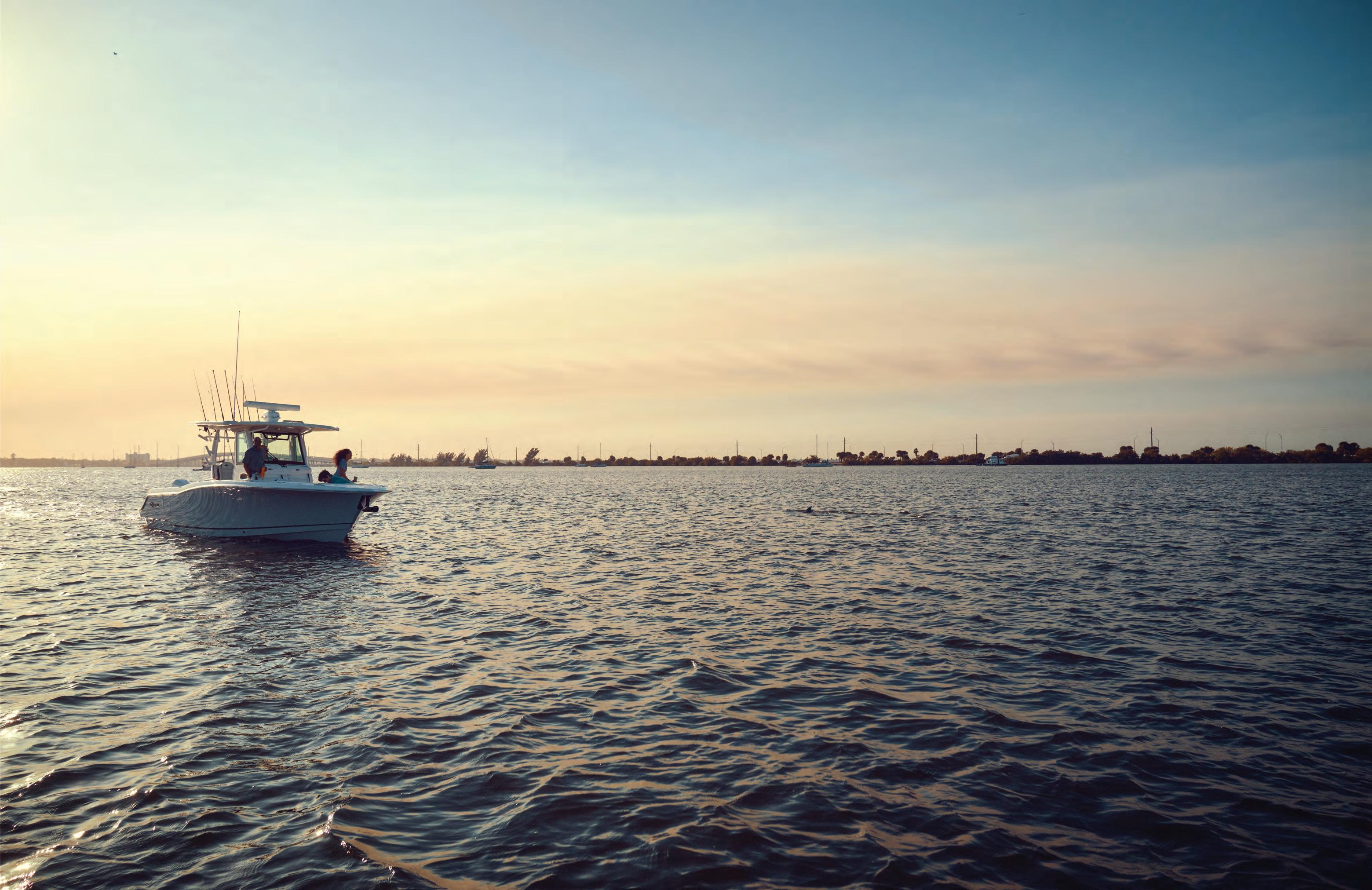
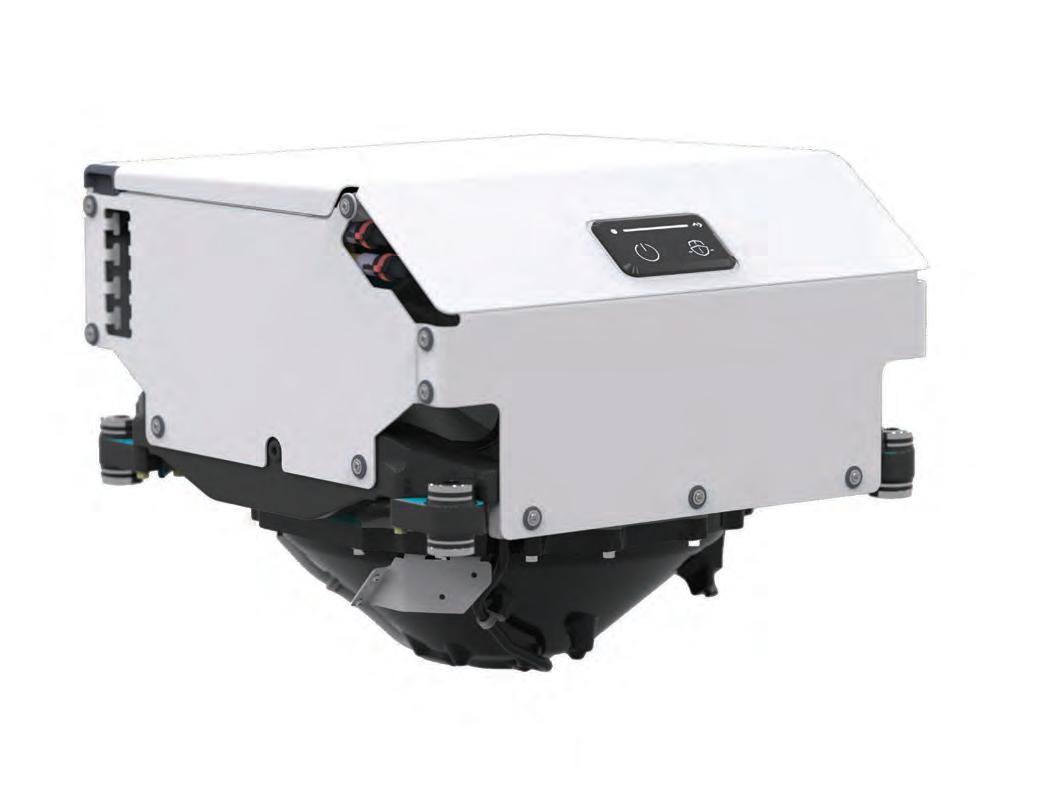



















Embarking on the open water is an exhilarating experience, flled with the promise of adventure and relaxation. Whether you’re a seasoned sailor or a weekend cruiser, protecting your vessel with proper insurance is not just a choice—it’s a necessity. Explore the reasons why every boat owner should prioritize boat insurance for a worry-free voyage.
The open water can be unpredictable, with unexpected storms, collisions, or other potential accidents. Boat insurance can give you fnancial protection if there is damage to your vessel, providing coverage for repairs or replacement.
Accidents on the water can result in damage to other boats, docks, or even injuries to passengers. Boat insurance offers liability coverage, which can pay for damages or injuries you’re liable for while boating, up to specifed limits, and lawsuit costs if you’re sued. This includes damage you cause to another watercraft or if someone on or near your boat is injured and you’re found to be legally responsible.
Unfortunately, boat theft and vandalism are realities that boat owners face. Boat insurance has comprehensive and collision coverage that can protect you against events outside of your control, including theft and vandalism.
Accidents on the water may lead to injuries for you or your passengers. Boat insurance offers a range of optional medical payments coverage limits, helping to cover medical expenses if you are in an accident or someone is hurt on your boat, regardless of fault.
If you fnanced the purchase of your boat, most lenders require insurance coverage to protect their investment. Having boat insurance not only fulflls these requirements but also gives you peace of mind knowing that your fnancial interests are safeguarded.


Some water municipalities and marinas may require proof of insurance for docking or accessing certain areas. Boat insurance allows you the fexibility to explore different destinations without worrying about entry restrictions.
Emergency towing and assistance
Progressive boat insurance can include optional Sign & Glide® On-Water Towing coverage. If your boat is disabled or breaks down on the water, Sign & Glide® pays for on-water towing, jump starts, soft un-groundings, and fuel delivery.
Wreckage removal
If your boat sinks, Progressive boat insurance will cover the cost of removing your boat from the water (if removal is legally required).
Investing in boat insurance is not just about protecting a valuable asset; it’s about safeguarding the memories, experiences, and joy that come with your on-water adventures. Don’t let unforeseen circumstances disrupt your journey—navigate with confdence, knowing that Progressive boat insurance has you covered. Ensure a smooth and worry-free voyage, because when it comes to your boat, peace of mind is the ultimate luxury.
Scan to get a quote in as little as 4 minutes
learn more.





















May is one of my favorite months for o!shore shing, as the shing seasons coincide with good weather. Being spared from the beginning of hurricane season until next month, right now is the most reliable time to get nice weather days to make the trek to deeper waters.
Mahi season has begun to be more consistent, making the trips o!shore more exciting and worthwhile. When making the long drive to the humps for black n tuna, or the sword sh ledges, it’s always a plus to know that you have opportunities to catch mahi on the way there and back. Staying alert for weedlines, diving birds and oating debris makes the trip seem like less of a chore, and keeps that sherman’s optimism alive for more of the venture, knowing you’re still on the hunt nearly the whole way back to the dock.
With the prevalence of mahi, tuna, queen snapper and sword sh in our deepwater shery, May 1st marks the opening of grouper season here in e Florida Keys, providing additional catching opportunities for both nearshore and o!shore adventures. We also welcome the opening of tile sh this month.
For those with an electric reel setup in their arsenal, this is a great month to get out there and scout for new deep-dropping locations. With snowy grouper and yellowedge grouper found peppered throughout the area, test dropping on new found spots can be a fun addition to mahi shing. As you run aimlessly o!shore looking for
signs of dolphin sh, you may notice you run over a ledge or depth variation. Anything that looks shy a%er about 500’ could be your next honeyhole.
By Capt. Quinlyn Haddon

If this is a new area especially, use a variety of baits on your 5-hook deepdrop rig to ensure your best chances of surveying the location. Squid is always a good choice o!shore, with many species unable to resist its potent aroma, but chunks of sh should be included to entice a grouper bite. With bait sizes matching hook sizes, its a good idea to make your own rigs with di!erent sized hooks if you’re unsure of the species that might be available at a new place. A x larger hooks near the bottom of the rig for grouper baits, and smaller hooks near the top with squid for tile sh.
If o!shore isn’t your thing, there are plenty of grouper on the reef and wrecks nearshore this time of year as well. However, a%er releasing these sandwich providers since their closing January 1st, every local sherman in town will be hitting the wrecks hard for the recaptures now that season is open. Before they face all this pressure from being targeted nearshore, particularly on publicly known wrecks, it’s a good time to put some skin in the nearshore grouper game.
A%er a short closure for the month of April, amberjack has also opened again this month.
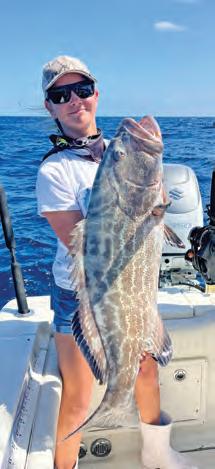
ese sh are easy to nd, and add some nice backbreaking action to the grouper hunt.
Whatever your avor of shing is, e Florida Keys has you covered this month. With the anticipated opening of grouper season at the beginning of May, and schools closing for summer break nearing the end, it’s a good idea to get booked for a charter before you arrive on your Keys vacation.
Give us a call at Sweet E’nuf Charters to get tight.
Capt. Quinlyn Haddon guides with Sweet E’Nuf Charters out of Marathon, e Florida Keys. (504) 920-6342. www.captainquinlyn.com; IG: @captainquinlyn
Whether you’re chasing trophy fish or charting your next offshore course, your time on the water deserves the best in navigation and marine technology. Defender brings you UNBEATABLE PRICES and EXPERT SUPPORT on Lowrance and Simrad electronics—trusted by professionals and weekend warriors alike.

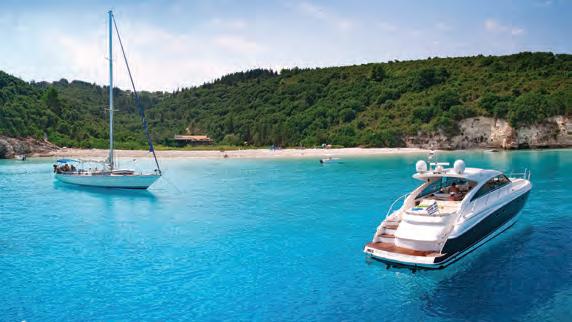
and navigation that keeps you locked on target.



No ofense to those nifty little knives that the Swiss pack a kitchen into, but sometimes it takes a big blade to get the job done. Tat was the case three years ago when I found myself in the jungles of Argentina.
I’d heard a tale about lost Inca gold and was on the hunt for clues. Among other things, the Inca were known for their extensive road system that ran at least 25,000 miles along South America’s eastern side. But the clue I was looking for was down a long-abandoned road overtaken by jungle.

Join the over 492,000 sharp people who own Stauer knives
That’s when my Pathfinder Blade came to the rescue. Constructed of high-quality 420 surgical stainless steel and with a total length of 16 inches, this full-tang knife made quick work of the jungle brush. And with its rugged handle of genuine, natural white bone that’s been hand-carved and torched with an iconic design, I didn’t lose my grip. Rounded off by brass spacers, handguards, a brown pakkawood handle, and hand engravings on the blade’s spine, this baby is all you could ever handle in jungle brush.

Upon reaching a stone wall hidden by the jungle, I snapped my knife back into its tooled genuine leather sheath and read the markings the Incas had left long ago. It was time to travel north for the next part of my adventure.
To make your next adventure even better, we’re including a pair of Stauer Flyboy Optics® Sunglasses— a $99 value—FREE with your purchase of the Pathfinder Blade. Lightweight, and ready to go wherever you do, these sunglasses are the perfect companion to help you stay sharp on the trail.

Flyboy Optics® Sunglasses a $99value with your purchase of the Pathfinder Blade




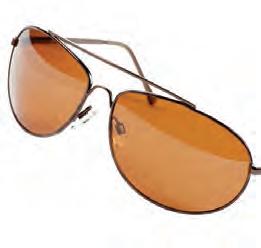




What Stauer Clients Are Saying About Our Knives
“This knife is beautiful!” — J., La Crescent, MN Knife Specifcations:
• 16" total length.
• High-quality 420 surgical stainless steel blade
• Full-tang construction. Handle of genuine, natural white bone that’s been hand-carved and torched

• Brass spacers and handguards, brown pakkawood handle, and hand engravings on the blade spine
• Leather sheath included Pathfinder Blade

$349 $99* + S&P Save $250
California residents please call 1-800-333-2045 regarding Proposition 65 regulations before purchasing this product.
*Special price only for customers using the offer code.






By Riley Love


nly in the dreams of shermen does this occur. A wondrous game sh pursued across ve countries not only awaits but the biggest, baddest, best of them lay for you in a single place.
e Salminus Brasiliensis is certainly not related to salmon, but is of the order Characiformes which includes many species— notably vampire-fanged payara and modern cinema star piranha in South America and tiger sh in Africa. Redundantly named the golden dorado (dorado means “golden” in Spanish), it’s immensely powerful, acrobatic—and magni cently beautiful.
e Rio Uruguay (indigenous Guarani interpretation “bird river”), with the northern border of Argentina and southern of Uruguay, sports a massive hydroelectric dam, the “El Salto Grande.” Stunned eels and bait sh ow through the locks in highly oxygenated water to the waiting predators. Permits are required by the dual operators on the Argentinian and Uruguay sides of the river to sh within 1,000 meters from the dam. Fishing is rigidly structured into slots of three hours quartered per weekdays per group of two or three anglers in two boats in this “Zona.” e Argentinians lost their permits recently and our two cra% had the entire area to ourselves. Downstream, twenty other boats oated outside the zone a kilometer away, prohibited from approaching nearer. My inner voice asked, “How o%en does this happen to me?”

ere are a lot of places to sh for golden dorado in Argentina, Bolivia, Paraguay, Uruguay and Brazil. One would note that the world record is a bit cloudy; there is a 70 lb. specimen claimed in 1970 but without a veri cation or a photo. To re ect on the quality of this shery, the current IGFA record is just over 55 lbs. and taken at La Zona. Our group landed numerous sh into the mid-40 lb. range, within 80% of the documented record. In contrast, the renowned, luxurious golden dorado destination, Pira Lodge, gets about one sh over 30 lbs. annually. shermen do well here. Locals target carp-like boga both for live bait and food. Using large topwater poppers, Rapala style diving minnows and handmade jigs, we hit rocky structure and fastmoving torrents. e dorado were exceedingly sensitive to water levels and ow being released from the dam. When it happened and their buttons were pushed, it was double digit trophies in each time slot. Multiple hookups were common.

Fishing teaches us lessons about life. Whether love, war or business, if you want success you need multiple opportunities. Even with shoulder- wrenching, reel-screaming strikes and Hank Aaron grade roundhouse hooksets, over half of what seemed like solid hookups would suddenly vanish from the transaction. It’s very much like trying to land large toothy- jawed payara. e modus operandi of these golden hulks revealed that even extra strong hooks were straightened, sometimes pulled from the lures; 65 lb. braid and wire leaders were broken. But some just “Houdinied” away, still waiting for you to come, instead of only dreaming.
Justi Campa of Fly Fishing Patagonia assisted with our planning. Reach them by emailing jcampa@ y shingpatagonia.com or visit www. y shingpatagonia.com.

Riley Love is a physician and author with homes in Kentucky and Key Largo, Fla. He has penned dozens of articles on international sport shing and a host of screenplays. He is a member of the International Game Fish Association, e Bill sh Foundation and the Outdoor Writers Association of America. Contact him at 270-816-4423, rjhclove@gmail.com or visit his website: rileylove.com.




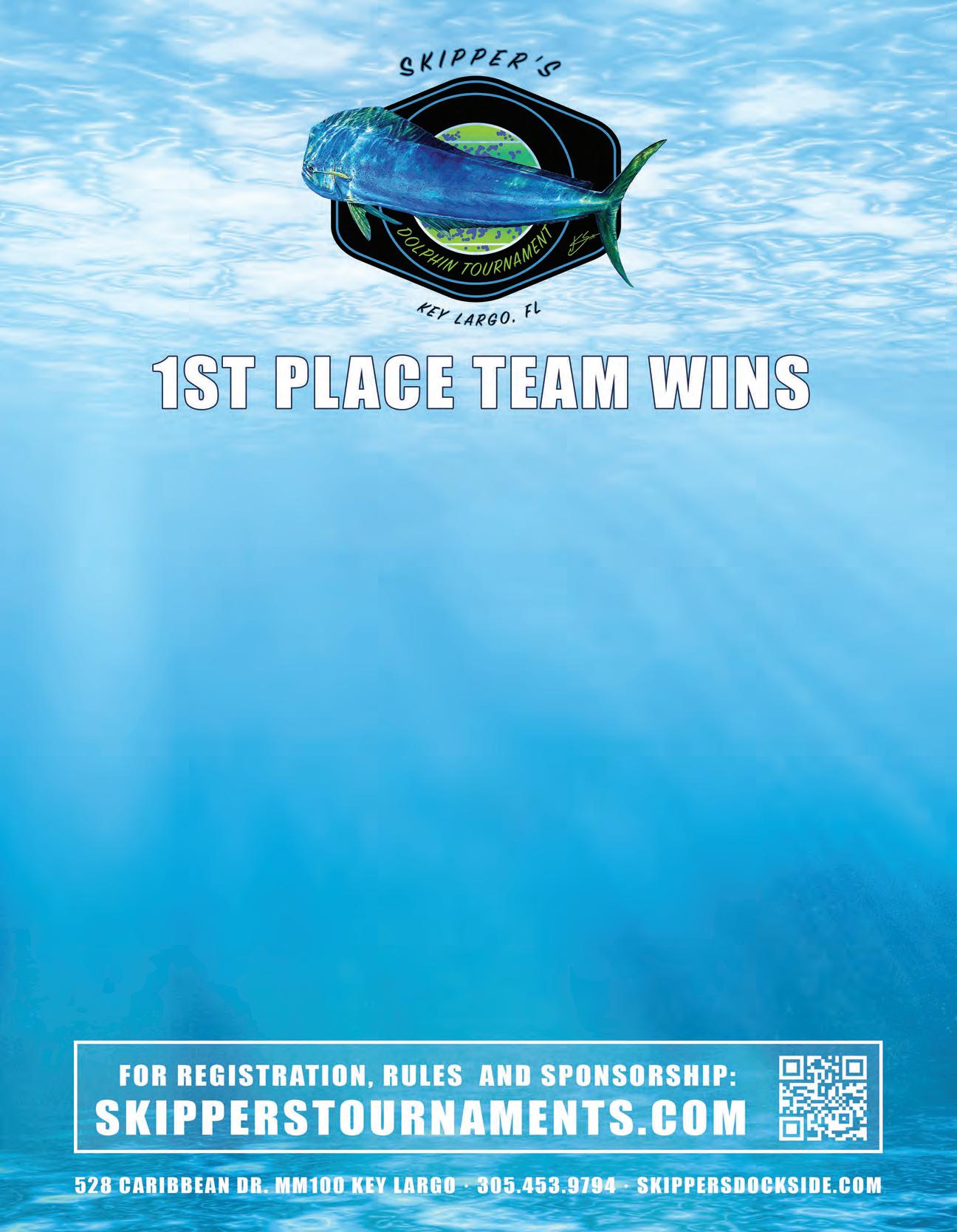

Performance Bulletin Available

60 YEARS OF REPOWER EXPERIENCE!
Mastry Engine Center has received the Suzuki Marine Super Service Award and has been ranked #1 in Suzuki Marine US Sales!
Repower packages designed to best ft your needs and not stretch your budget. Financing available.
Suzuki RePowers include a fve-year Factory Direct Warranty.

Stationed strategically around the southeast, all Suzuki RePower Centers have achieved the highest level of Suzuki Service Certifcations to meet and exceed your repower needs.
Many of our Suzuki RePower Centers feature Water Accessible Drop Travel Lifts.






It’s no fsh tale when you run with a John Deere. You can get everything done faster and easier, so you get more time on the water. Plus, our special offers make them the catch of the day.






By Capt. Michael
If you’re a dedicated trout angler like me, you’re probably eyeing the opportunity to land a personal best speckled trout before the spring spawn.
While most Texas anglers focus on big trout from mid-December to early April, May o!ers a prime window for trophy sh, especially with the full moon on May 12 this year. e warmer weather also makes shing more enjoyable, creating a perfect environment for those seeking action-packed outings.
May sees many anglers shi$ing focus and putting away their waders. However, big speckled trout are still holding onto their eggs, making this an excellent opportunity to catch one before they spawn. e pleasant temperatures in May allow us to use more aggressive lures and speed up our presentations, a welcome change from the slow, careful approach required in
winter. For those who enjoy a faster pace, May is the time to go.
One of my favorite techniques for targeting trophy trout in May is using topwater lures. e explosive strikes on the surface are thrilling, and the warmer waters make sh more eager to strike. But topwater isn’t the only option—slow-sinking and suspending lures also perform well. As a paddletail enthusiast, I recommend experimenting with 3”, 4”, and 5” sizes and adapting to the sh preference. At this time of year, trout are aggressive, so adding rattling sounds to your lures can make a di!erence.
In terms of location, I prefer shing grass %ats in water that is knee- to waist-deep. Flats with small creek drains or depressions are incredibly productive, as these features tend to concentrate sh. Shallow grass areas are ideal, and potholes can increase your chances of nding a big trout. ese areas o!er an excellent opportunity to catch a he$y sh before the season transitions.
However, shing in May can be challenging due to the abundance of small bait sh in the water, like tiny glass minnows. Trout are o$en gorging on these minuscule meals, making it di&cult to grab their attention with larger lures. e key is downsizing your lures to match the size of the bait sh. I’ve found that using the smallest lure you can cast e!ectively is the best approach when you see an abundance of small bait sh. Both hard and so$ lures are e!ective, and colors like white and silver tend to mimic the forage closely.
When shing around bait balls, I recommend positioning your lure on the edge or beneath the school. is strategy attracts sh to a single target, rather than competing with a large mass of bait sh. Slow-sinking lures are ideal, as they give the appearance of wounded prey, which trout nd irresistible.
Tandem rigs are another excellent option for spring shing. By rigging two smaller lures, you can cast farther while still maintaining the proper lure size. A combination of small silver spoons and white bucktails works well when shing around glass minnows. A small %oater diver with a spoon trailer also adds an extra level of action.
In the spring, downsizing your lure presentation can make a signi cant di!erence in your success, potentially leading to the big trout you’ve been waiting for.
Capt. Michael Okruhlik is the inventor of Knockin Tail Lures®, and the owner of www.MyCoastOutdoors.com.



Late spring through summer marks the prime season for tripletail !shing in the Florida Keys. Known for their unique appearance and strong !ght, these !sh are a favorite for anglers looking to challenge their skills. Tripletail are opportunistic feeders, o en lurking around oating structures like buoys, weed lines, or even debris in the water, so learning how to spot them and presenting the right bait are key to a successful catch.
By A. deGruchy
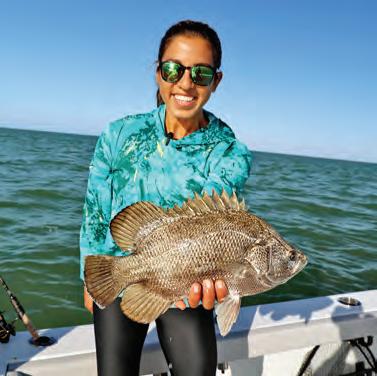
When targeting tripletail, it’s important to have the right gear for the job. A 7’ to 7’6” medium rod with a fast action will provide the strength and responsiveness needed to manage their powerful runs. Pair this with a 3000–4000 size reel. We rely on the PENN Battalion paired with the 3500 PENN Authority as our personal set up. For leaders, a 20 lb. uorocarbon leader is good, along with a 3/0 circle hook. We trust the Mustad UltraPoint hooks for their sharpness and strength. For bait, shrimp or small white bait are both top choices.
Finding tripletail requires enough daylight and minimal clouds for visibility. $ey prefer oating structures such as buoys or patches of oating seaweed, so keep an eye out for these areas while cruising the waters. A key factor in casting is to land as light as possible near the !sh, allowing the bait

naturally with the current. Tripletail are o en slow movers, so be swi and avoid sudden movements that might scare them o%. A light and steady retrieve will give your bait the best chance of getting tight.
Tripletail !shing in the Florida Keys can be incredibly rewarding, especially when you hook into one of these feisty !ghters. $ey also make excellent table fare if you wanted to catch and cook, getting the full sea-totable experience.
Book your adventure now at www.beansport!shing.com as our trips !ll up fast!
Follow deGruchy’s adventures at @bean_sport shing on Instagram and YouTube.















ShoreStation hydraulic boat lifts are a reliable choice for coastal residents and boating enthusiasts alike. Their strong construction, made with corrosion-resistant materials, allows them to withstand harsh environmental conditions, including sun, storms, and saltwater damage. ShoreStation provides a steadfast solution for protecting waterfront investments, o ering peace of mind to owners in the Sunshine State.







Equipped with exceptional weather resistant fabric and breathable SunTex 80 woven mesh ends for maximum protection and durability,

Made from the highest quality materials, our innovative hydraulic boat lift is one of the fastest and safest lifts on the market today. When you have a hydraulic lift, there’s no need to worry about wind and waves getting in your way. This lift will give you con dence to safely land and secure your boat in less-than-ideal conditions.
Never miss another moment on the water. Power your lift with clean, free solar power. Our speedy 20 watt charger features solar regulator drainage protection, saving your battery from permanent damage caused by overcharging.



Florida’s bass !shing scene just got a serious jolt of excitement, thanks to an unforgettable day on the water for angler Alie Abrell. Back in February, in the heart of Marion County, Alie landed what many dream of but few achieve—a jaw-dropping 10-pound largemouth bass that has quickly become the talk of the !shing community.
Fishing with the renowned Trophy Bass Expeditions and under the seasoned eye of Captain Sean Rush, Alie hooked into the massive bass during what turned out to be a picture-perfect outing. As the !ght unfolded, it became clear this was no ordinary catch. When the !sh !nally surfaced, it was con!rmed: Alie had o&cially entered the elite double-digit club—a milestone that every serious bass angler aspires to reach.
$e catch is more than just a personal triumph for Alie—it’s a sign that Florida’s peak bass season is o% to an electrifying start. Known for its trophy-sized bass and scenic waters, Marion County is already delivering on its reputation, and this monster catch sets a high bar for the rest of the season.
“Moments like this are what we live for,” said Captain Rush. “To see an angler connect with a !sh of that caliber—it’s unforgettable.”
As word of the catch spreads, anglers across the Sunshine State are gearing up for what promises to be a record-setting year. With warming waters and peak season just ramping up, it’s a prime time to get out there and chase giants.
Huge kudos to Alie for reeling in the bass of a lifetime—and a big shoutout to Captain Rush for once again guiding an angler to glory. If this epic moment is any indication of what’s to come, Florida’s bass !shing faithful have every reason to be !red up.
So, gear up and cast out—because the big ones are biting!
For more info visit https://license.gooutdoors orida.com/Angler/Home










First-Ever Five-Day Format Enhances Business Opportunities, Draws Strong
The 2025 Palm Beach International Boat Show (PBIBS) continues to set new benchmarks, drawing strong attendance and hosting an expansive selection of vessels, marine products, and exhibitors. PBIBS has become an essential destination for both professionals and consumers seeking the latest in boating and yachting.
For the first time in its 43-year history, PBIBS took place over five-days, providing an extended platform for marine professionals, manufacturers, and brokers to connect, conduct business, and highlight the latest advancements in the industry. Situated along the scenic downtown West Palm Beach Intracoastal Waterway, this year’s event delivered an enhanced experience for exhibitors and attendees alike, reinforcing its reputation as a key marketplace for the industry.
“The Palm Beach International Boat Show continues to attract an increasing number of domestic and international exhibitors, underscoring the event’s global reach and influence,” said Andrew Doole, U.S. Boat Show President at Informa Markets. “The industry’s response to the additional day has been overwhelmingly positive, providing buyers with more time to explore products, make purchases, and engage with exhibitors. This year further reinforced PBIBS as a premier business hub for the marine sector.”
This year’s show saw the largest participation of international exhibitors to date, including 16 Superyacht Builders Association (SYBAss) exhibitors and eight Large Yacht Brokers Association (LYBRA) members, further highlighting PBIBS’s standing in the global marine industry.
Jonathan Beckett, CEO of Burgess and LYBRA member, added, “the Palm Beach Show is one of the most important events on our US radar.




Please be sure to check out my YouTube Channel “Darcizzle Offshore” for fishing videos every week! www.youtube.com/DarcizzleOffshore
Boca Raton, Lake Boca Raton, FL - May 2025
































e have quite a diversity of species in our waters right now and May is feasibly the prime month of the YEAR to fish off the Palm Beaches! There are a multitude of factors as to why this is one of the best fishing months of the year. High winds should diminish, and water temperatures will quickly rise a couple degrees to average of 80°F giving the offshore angler greater opportunities to fill their fish box! The winds this month will primarily blow out of the E/SE quadrant which will trigger some very large pelagics to move closer to our coast. This time of the year will continue to produce a strong mahi mahi bite all the way through June, diminishing when the pelagics start moving further offshore. It’s a good idea for you to pay attention to the dolphin bite taking place off the coast of the FL Keys and Miami-Dade counties because it will be a good indicator for what you should expect in our waters within a few days’ time.
For the anglers that like to catch king mackerel, there will be a favorable morning bite in general. Typically, king fish can be found close to the reef in 90 to 120 feet of water from Boynton to Jupiter Inlet. Trolling spoons or slow trolling live bait with down riggers are the best methods for targeting king mackerel. The blackfin tuna will be abundant too, being in waters between the Breakers Hotel and the Lost Tree Club, as a well-known hot spot. Try fishing with live bait in 100 to 250 feet of water with a steady current water flow. The arrival of bait fish will start to show up in our waters this month. Pull out those cast nets and Sabiki Rigs. On your Sabiki Rig, attach a bucktail jig or pyramid sinker to the end of it and catch some bait close to shore on rock piles and wrecks!
Inshore fishing should produce excellent fishing as well. Jack crevalle will be schooled up tightly and will eat any live bait within their strike zone. Tarpon will start to show up in the inlets and juvenile fish can be found in the bays and canals. Try using live bait, jigs, and lip divers to entice a tarpon to bite. Snook should also produce plenty of exciting action; work artificial lures and flare hawks along seawalls, docks, and near structure. Finally, tournament season has officially begun with multiple events every weekend. Prepare yourself for heavy boat traffic on the weekends, especially on tournament days. Boating safety is always a primary concern for all water lovers alike. Be safe, follow YOUR dream, and keep on catchin’!
FROM

Sea Tow is happy to extend it’s service to include tows from Nothern Bahamas, Green Turtle, West End Marsh Harbour, Hope Town and Grand Cay to the U.S.
Whether you need a timely tow or help offshore, Sea Tow Captains are standing by 24/7. Why wait? Join today and get 2 months free! (That’s a $28 value!) Use discount code: TCT. Join Sea Tow Palm Beach \ 561-844-8056






By Keith Lozott Contributing Writer
www.swamptosea.com • 561-503-0848

WTypically, I don’t believe in superstitions, but a er a recent shing trip with my buddy Neil, I may be a believer!!! e morning started slow; I caught a small snapper and small snook. Neil was in skunk mode, so we decided to try a spoil island where I’ve caught some trout, snook, and a gag grouper on a prior trip. To our dismay it was dead as well. Just as we were about to exit stage le , Neil was working a topwater lure back to the boat when what appeared to be a large bull shark came up from the bottom and tried to hammer the lure. Unbelievably it totally missed the lure and disappeared. It was impressive to witness such a big specimen of a sh take a swipe at the lure.
By Keith Lozott Contributing Writer
A er the “Shark Week” experience, we continued to struggle so I decided to implement Plan C and move from the east side of the Indian River to the west side. I’ve had some nice shing on the west side with trout, reds, and snook. We made our way across the river stopping at another spoil island only to be greeted with a jack attack. I landed several jacks and Neil hooked one that got o . His skunk was still intact but with jacks around I gured that would change. Unfortunately, that wasn’t the case.
Bart Hayes put the Yo-Zuri Twitch Bait to work in the Everglades and caught an absolute giant peacock.
Typically, I don’t believe in superstitions, but a er a recent shing trip with my buddy Neil, I may be a believer!!! e morning started slow; I caught a small snapper and small snook. Neil was in skunk mode, so we decided to try a spoil island where I’ve caught some trout, snook, and a gag grouper on a prior trip. To our dismay it was dead as well. Just as we were about to exit stage le , Neil was working a topwater lure back to the boat when what appeared to be a large bull shark came up from the bottom and tried to hammer the lure. Unbelievably it totally missed the lure and disappeared. It was impressive to witness such a big specimen of a sh take a swipe at the lure.
A er the “Shark Week” experience, we continued to struggle so I decided to implement Plan C and move from the east side of the Indian River to the west side. I’ve had some nice shing on the west side with trout, reds, and snook. We made our way across the river stopping at another spoil island only to be greeted with a jack attack. I landed several jacks and Neil hooked one that got o . His skunk was still intact but with jacks around I gured that would change. Unfortunately, that wasn’t the case.
elcome to your May inshore, nearshore, and freshwater fishing forecast for South Palm Beach County. The weather is heating up and so is the bite. Lots of bait should be moving into the area this month and with it the usual characters will not be far behind. Typically, light winds cause the ocean to be flat in the mornings. So, I would suggest taking advantage of the conditions and try heading offshore before the sun gets too high in the sky. The blackfin tuna should be around and as shallow as 100 feet in the morning; they move deeper as the sun rises. If the conditions allow, head a little further out looking for mahi before coming back into the reef to catch rainbow runners and other assorted species. Snook fishing should also be great just about everywhere you look for them, on the beaches, inshore on docks, seawalls, and bridges. Tarpon will be in the inlet and beaches the next couple of months. Of course, they can be finicky, but if you put your time in, there is a decent chance of having success.
We used the trolling motor to quietly make our way towards the mangroves hoping to get a glimpse of a red, snook, trout, ounder, or any inshore species willing to bite. As we approached the shore, we noticed another bull shark working the shore and of course I had to make a cast or two at him, but he had no interest in my o ering. We kept working the shore and nally it happened for Neil!!! He made a long cast and almost as soon as the lure hit the water, he was on with a nice sh, but we couldn’t see what it was. He started gaining ground getting it closer; enjoying the ght and then it happened! e sh came unbuttoned and at this point I was like dude, what did you do in a previous life to deserve this??? We made our way toward a dock that I know holds snook. I made a long cast and right then I was hooked up with a huge sh. It was a big snook; I got her to the boat, revived her, and released her to ght another day.

Success! I said, “let’s go to lunch and call it a day”. I asked Neil if he was hungry and then he disclosed to me that he ate a banana for breakfast! Neil knows not to bring bananas on the boat (it’s bad luck), but it didn’t occur to him that the curse would remain in e ect with it digesting in his stomach. Myth con rmed or was it bad luck? He should’ve brought his lucky rabbit foot!!!
Wyatt came all the way from Washington to catch a snook and got it done in a big way.
We used the trolling motor to quietly make our way towards the mangroves hoping to get a glimpse of a red, snook, trout, ounder, or any inshore species willing to bite. As we approached the shore, we noticed another bull shark working the shore and of course I had to make a cast or two at him, but he had no interest in my o ering. We kept working the shore and nally it happened for Neil!!! He made a long cast and almost as soon as the lure hit the water, he was on with a nice sh, but we couldn’t see what it was. He started gaining ground getting it closer; enjoying the ght and then it happened! e sh came unbuttoned and at this point I was like dude, what did you do in a previous life to deserve this??? We made our way toward a dock that I know holds snook. I made a long cast and right then I was hooked up with a huge sh. It was a big snook; I got her to the boat, revived her, and released her to ght another day.

On the freshwater side, water temperatures will still be mild so the fishing should be pretty good across the board. Peacock bass, bass, and clown knifefish should all be feeding well on the Lake Osborne/Ida Chain. The fishing in the northern Everglades for exotics should remain excellent this month depending on the water levels. Hope you catch some good ones. Good luck out there!
Keith Lozott The Fishing Realtor
Success! I said, “let’s go to lunch and call it a day”. I asked Neil if he was hungry and then he disclosed to me that he ate a banana for breakfast! Neil knows not to bring bananas on the boat (it’s bad luck), but it didn’t occur to him that the curse would remain in e ect with it digesting in his stomach. Myth con rmed or was it bad luck? He should’ve brought his lucky rabbit foot!!!
Keith Lozott The Fishing Realtor
Give us a try and see what everybody is raving about! We put the “FUN” back into drift boat fishing! So sit back, relax you’re on Island Time!

This red snapper was a huge surprise for us in 15 feet of water outside of the Boynton Inlet.

& Saturdays from 6 to 10 pm
King Mackerel • Wahoo
Dolphin • Snapper (all kinds)
Sailfish • Grouper Bonito • Cobia
All licensing, bait & tackle included. + gratuity for crew

(Tuesdays 1-7pm)



















1
5

































Watercraft Rentals
Transient







with Chris Thalmann
Welcome to May, also known as National Wetlands Month! Originating back in the early 1990’s as a way to help raise awareness about the value of wetlands as a nature resource, the annual event has morphed into a celebration of some of the best of nature.
Wetlands are found in every US state...including our more arid states like Nevada, Arizona, Utah, and New Mexico. Ranging in size from backyardsmall to many millions of acres, the definition of what makes a wetland can - and does - change over time.

Some of those changes have been science-driven, while others have been influenced by politics or economics. But at the heart of it, wetlands are transitional areas, located between persistently dry upland areas and more permanently wet areas.
They represent an incredible ecological resource, fostering a wide array of regional biodiversity. They’re also important recreational and economic components for local areas, helping get people outside to enjoy nature, as well as bringing tourism dollars to local communities.
But it hasn’t always been this way. It wasn’t until the 1970s that the US began to regulate the filling and dredging of surface water areas, including wetlands. And it wasn’t until the 1980s that Florida took significant steps toward protecting its own wetlands.
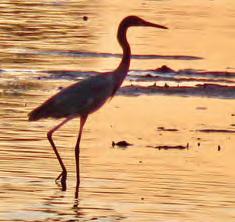

Often called swamp land, marsh land, bottom land, mud flats, or wasteland, much of the growth in Florida and elsewhere that took place up until the 1970s and 1980s was at the expense of wetland areas. Too wet to be “useful”, the only value seen in many wetland areas back then was tied up in filling and drying-out the land to build roads, farms, homes, shopping centers, offices, hospitals, and whatever else was needed in growing communities throughout the state.
Florida has approximately 35 million acres of land, and at one time was thought to have about 20 million acres of wetlands. 11 million acres remain, more than any other state except Alaska.
So, while Florida has lost almost half of its original wetland area, the good news is that a huge chunk of wetlands remain. And although nothing is ever certain in this world, those wetlands remain well-protected.
With more than 30,000 acres of natural lands managed by Palm Beach County, tens of thousands more acres managed by the state, and millions more acres managed by the federal government, there are lots of opportunities to go experience the natural beauty of a wetland!
May is a great time to explore. Trails are still mostly dry, and temps are not too high. If you can avoid the heat of the day and visit closer to sunrise or sunset, you’ll also have a better shot at seeing more wildlife.
Hope to see you outdoors!
CONTINUED FROM PAGE 1 PBIBS RECAP >>
It’s where the buyers are, and our sales continue to show how vital this market is.”
PBIBS 2025 featured an extensive collection of boats, with more than 600 exhibitors displaying a variety of notable vessels. Exhibitors from around the world leveraged this opportunity to connect with a highly engaged audience, including prospective buyers and key stakeholders.
In partnership with Superyacht Times, the show hosted a lineup of industry-focused seminars providing insights into emerging trends. For the first time, the event also featured a Q&A session with officers from U.S. Customs and Border Protection (CBP) and the U.S. Coast Guard, offering guidance on charter operations and foreign crew employment aboard U.S. and foreign-flagged vessels.
Beyond its impact on the marine sector, PBIBS remains a significant economic driver for the region. “The success of PBIBS extends well beyond the docks,” said Alyssa Freeman, Executive Director of the Marine Industries Association of Palm Beach County (MIAPBC). “Each year, the show generates substantial revenue for Palm Beach County businesses, supporting the local economy and reinforcing the importance of the marine industry to our community’s growth.”
In alignment with its commitment to industry development and community collaboration, the boat show organizers donated over $300,000 to the MIAPBC grant program. These funds support marine-related educational initiatives, workforce development programs, and nonprofit organizations dedicated to sustaining and advancing the industry in Palm Beach County and beyond.
As PBIBS continues to evolve, planning is already underway for the 2026 show, scheduled for March 18 - 22. For more information on the Palm Beach International Boat Show, visit https://www.pbboatshow.com.


























The Solid Waste Authority of Palm Beach County is looking for students to participate in a one-week (reduce, reuse, recycle and rethink) adventure into the world of waste. During this week, students will engage in hands-on activities and field trips focusing on the environment from an integrated solid waste management perspective.
After all students learn about the concept of AWAY, they’ll graduate as official SWA 4R Ambassadors and be encouraged to teach their family and friends about how their waste can affect our environment.

◄ 4R Ambassador participants testing water samples at Lake Altman, West Palm Beach
Dates: June 2-6
Students interested in the 4R Ambassador Summer Program should meet the following criteria:
☑ Completed grades 6, 7 or 8
☑ Minimum 3.0 GPA (transcript from school)
☑ Recommendation letter from a science teacher

The cost to participate in the 4R Ambassador Summer Program is an old electronic device, which will be recycled. For more information, visit swa.org/4r.
By Mark Ambert

On a tough fishing trip this past month I was once again reminded that somehow — someway — the truly great angler can make a bad day successful. My friend Carl Lombardo is one such person.
On a day when the weather was hell and absolutely nothing good was happening, he turned an otherwise miserable morning into a memorable day by catching his personal best blackfin tuna.
I’ve come to realize anglers can make a huge difference in the outcome just by their level of preparedness. Through knowledge and accumulated skill, he found a way to make a tough day work out.
Sometimes it pays to review the basics with regards to what makes for a successful day’s fishing, especially when you’ve been on the water for several trips but with limited success. Here are some essential skills particularly for saltwater fishing that can enhance your experience and success. Focus on continual improvements in each of these areas and you will change the odds to your favor:
Learning how tides affect fish behavior is key to understanding how, when, and where they will feed. Utilize this vital information to find productive fishing spots based upon bait availability and movement. React to tide and current changes accordingly and you will stay in the game.
So many anglers fail to tap into the extensive array of useful features found in modern day electronics. Understanding the full capabilities of GPS and fish finders can be as important as learning to navigate the water. Spend the time to understand sonar readings and imagery to help locate and identify your quarry.
Recognizing local species and their preferred habitat is critical to success. Understanding seasonal patterns and behaviors are just two areas where knowing your quarry can make the difference between success and failure.
Choose the right gear based on target species and environment. Have a selection of gear handy and onboard in case your target species is uncooperative. Be able to cover all aspects of the water column (surface, mid-level, and bottom) with the gear onboard.
Learn essential knots (Palomar, improved clinch, loop knot, etc.) and rigs and be proficient at tying them. Relying on these skills when out on the water can sometimes be challenging. Rough water and weather conditions can intensify the level of difficulty, so know a handful of knots and rigs well. Understanding the difference between a “chicken” and a “laydown” rig and when to use them will put fish in the boat.
Master different techniques for presenting live bait and lures. Practice accuracy for targeting specific areas and species especially when site casting. Have your gear already set up and ready to cast – nothing worse than watching a school of mahi cruise by and leave before someone can get a bait or lure in front of them.
Understanding anchoring and drifting techniques are essential skills that need to be practiced then executed with precision to successfully fish the numerous wrecks and reefs available to the offshore angler. Don’t underestimate the importance of boat handling. Keep your boat under power and control when bringing a big fish alongside. Backing down on an unruly billfish can spell disaster or success. Doing this well will help put that prize fish in the boat.
Recognize how weather affects fishing conditions including temperature, tides, wind direction, barometric pressure, and lunar phases. Understanding how these conditions affect your target species will improve the odds.
Know the safety protocols for fishing in open water. First aid and emergency response are crucial for fishing-related incidents. Have a marine Medi-kit onboard and easily accessible in case of emergencies. Also, have a small boltcutter onboard when the inevitable happens and someone gets “hooked”.
These items and skills can significantly enhance your effectiveness and enjoyment while fishing. Mastering any of these areas will improve your success!
Ambert, IG @marksgonefishing_™ marksgonefishing25@gmail.com_




Welcome to the Coastal Angler Magazine local fishing report. As we head into the month of May, deep sea fishing in South Florida, particularly around Palm Beach, continues to offer some of the best opportunities for anglers. With the warming waters and the peak of spring fishing season, this is a prime time to target a variety of big-game fish in the region. Whether you’re fishing from a private boat, a charter, or even a pier, the waters around Palm Beach are teeming with life.
May brings warmer waters to the region, with temperatures typically ranging from 75°F to 80°F. These warm conditions create a perfect environment for many of the area’s target species, with offshore waters near the Gulf Stream remaining relatively calm. The Gulf Stream, which flows close to the Palm Beach coastline, plays a critical role in the abundance of fish species, as it provides nutrient-rich waters that attract baitfish, which, in turn, bring in larger predators.
May is also part of the transition from spring into summer, so you can expect more consistent fishing conditions. Winds tend to be light during this month, although some fronts can bring short periods of rough seas. Anglers should plan accordingly, keeping an eye on the weather forecasts for the best fishing days. Here are some of the pelagics that we will be targeting.
Mahi-mahi (dorado) are always a popular target in Palm Beach during May, with many anglers heading offshore to pursue these beautiful fish. Mahi-mahi are attracted to the floating debris, weed lines, and rip currents,
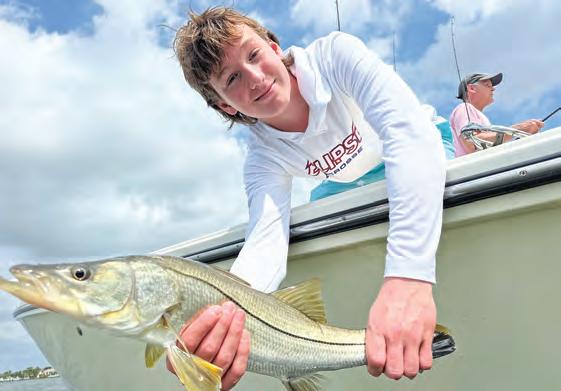
Happy Mother’s Day! May offers great fishing for the Jupiter and Palm Beach area. Local waters are teeming with a plethora of species, so anglers can expect plenty of rod bending action.
Snook fishing heats up as snook start to migrate to local passes and beaches for their upcoming spawn. The snook can be seen cruising along seawalls and docks in search of food. Live bait and D.O.A. 3” Shad Tail on a 1/4-ounce jig head casted in their vicinity will get your drag screaming.

which are prevalent in May. These fish put up an exciting fight and offer excellent table fare. Mahi range from 10 to 30 pounds, with larger specimens possible further offshore.
Sailfish, though the peak of sailfish season typically occurs during the winter months, many of this species remain in the region as the Gulf Stream continues to pass close to the shore. May offers a late opportunity to hook one of these fast, powerful fish. Live bait, such as goggle-eyes or pilchards, is effective when trolling around the weed lines or on the drop-offs where the deep waters meet the continental shelf.
Wahoo are another highly sought-after species in May, known for their speed and strength. These fish are often found in deeper waters beyond the 200-foot mark, where they chase schools of smaller baitfish. Trolling at high speeds with lures or ballyhoo rigged with skirts can trigger a bite.
Yellowfin and blackfin tuna are also a great target for May, particularly if you head out to deeper waters where these fish tend to concentrate around offshore structures and rip currents. Blackfin tuna are more abundant inshore and can be found in waters between 150 to 300 feet deep. Yellowfin, being more migratory, can be found in deeper waters beyond the 300-foot mark.
Good luck, keep an eye on your surroundings, and tight lines!
Bait schools will be in our local area, and this is the time for topwater action. Rapala Skitter Walks worked over open flats and near heavy structure causes for some explosive action. If you have never experienced topwater action for snook, I recommend you try it, there is nothing like it. The snook will range in size from 5 to 20 pounds.
Tarpon “silver king” provide awesome fishing, acrobatic leaps, and drag screaming runs for anglers. Tarpon can be found in the ICW, local inlets, and beaches. Live baits like mullet or pinfish work great. Artificial lures, D.O.A. 3” Shad Tail, or a D.O.A. TerrorEyz will get the drag screaming.
The inshore waters will also be alive with jacks, sharks, ladyfish, snapper, and many other species, putting a bend in the rod. Live bait that’s freelined with the tide or Rapala X-Rap will get the strike.
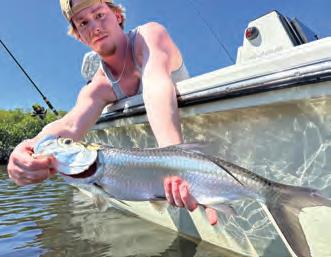
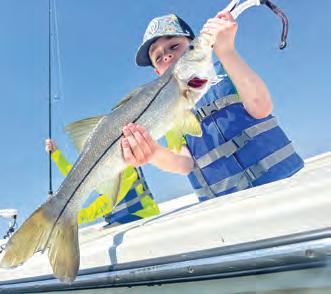
Well, that’s the fishing forecast for May. I hope everybody enjoyed, now get out there and experience the thrill of drag screaming action.

May, it’s for sure my favorite month out of the year for fishing in South Florida. Snook will be back as the main target inshore this month. Fishing seawalls, bridges, and docks are your best bet. Beef up your tackle a bit to be able to pull these fish from structure. I like using a Crowder Rods 7 foot 12-25lb. E-Series. Teaming that up with a live mullet and circle hook on 60lb. fluorocarbon leader. For artificial lures, a Yo-Zuri Lures Topknock or a D.O.A. Bait Buster are both great options.
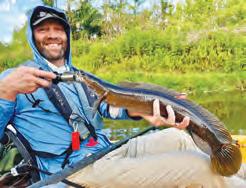

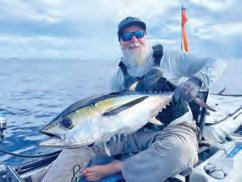
May really kicks off the best time to fish offshore. Weather, numbers of pelagics, and bait should make this month enjoyable. Mahi, tuna, sailfish, wahoo, and kingfish will all be in the normal trolling waters of 60-250 feet of water. I really like to focus on tuna using a vertical jig. A Catch Fishing jig dropped in 200-300 feet of water can be deadly on these fish. Look to focus on getting your jig to the midwater column and mix in a variety of different speed retrieves. If you like to use live bait, goggle eyes, pilchards, threadfins, blue runners, and mullet will all be good presentations. Slow trolling these baits in 80-200 feet of water will get you a bite. If you are looking to keep it artificial, try running a deep diving YoZuri Crystal Minnow.
Peacock bass, snakehead, and clown knifefish will be chewing this month. Prop baits will work well for peacock along shallow edges. Try a black frog in the same areas for snakehead. I like using 15-pound Yo-Zuri fluorocarbon leader, a 2/0 circle hook, and a shiner casting in and around weed lines to get onto a few clowns. Look to fish the midwater column and below by adding a pinch weight to your leader and get that bait in their face.








8 Thu 6:48 2.4 7:23 2.5 12:49 0.4 1:08 0.1 6:35 7:57
9 Fri 7:30 2.4 8:05 2.6 1:34 0.4 1:49 0.0 6:34 7:58 10 Sat 8:09 2.4 8:44 2.7 2:15 0.3 2:26 0.0 6:34 7:59 11 Sun 8:46 2.4 9:22 2.7 2:53 0.3 3:02 -0.1 6:33 7:59
12 Mon 9:23 2.5 9:59 2.7 3:30 0.3 3:37 -0.1 6:32 8:00
Tue 10:00 2.4 10:37 2.7 4:05 0.3 4:12 -0.1 6:32 8:00











19 Mon 2:14 2.4 2:28 2.2 8:21 0.5 8:42 0.2 6:29 8:04
20 Tue 3:06 2.4 3:31 2.3 9:22 0.3 9:47 0.3 6:28 8:04
21 Wed 4:01 2.4 4:38 2.4 10:24 0.2 10:52 0.2 6:28 8:05
22 Thu 4:58 2.5 5:43 2.6 11:22 0.0 11:54 0.2 6:28 8:05
23 Fri 5:55 2.5 6:44 2.8 12:18 -0.3 6:27 8:06
24 Sat 6:52 2.6 7:42 3.0 12:52 0.1 1:12 -0.5 6:27 8:06
25 Sun 7:47 2.8 8:37 3.1 1:46 0.0
28 Wed 10:27 2.9 11:13 3.1 4:23 -0.1 4:43 -0.6 6:26 8:08
29 Thu 11:20 2.8 5:16














































Everglades University (EU) is proud to announce its partnership with the Guy Harvey Foundation (GHF), a collaboration dedicated to promoting sustainability and environmental conservation through education. This partnership aligns with EU’s commitment to fostering awareness and action in marine conservation and sustainability.
A highlight of this partnership is the speaker series designed for EU students. This five-part series will feature recorded presentations from leading figures in the GHF, including world-renowned marine conservationist Guy Harvey, GHF CEO Jessica Harvey, and esteemed experts Steve Roden, Greg Jacoski, and Tonya Shearer. Each session will explore critical aspects of sustainability, ranging from research, conservation, and legislation to conservation entrepreneurship and ocean stewardship, and will include a live Q&A session via Teams.
Everglades University President and CEO, Kristi Mollis, recently took the stage as a distinguished panel speaker at the Conservation Summit. Addressing over 250 educators, she emphasized the importance of environmental stewardship in education. The summit featured notable conservation leaders, including Jessica Harvey, Chief Zoological Officer Chris Dold of United Parks & Resorts (SeaWorld, Busch Gardens & Discovery Cove), and Candice Wade, Director of Suncoast Youth Conservation Center.
Everglades University and the Guy Harvey Foundation are also developing an educational video series aimed at middle and secondary school students. These short videos will introduce young learners to careers in coastal and marine management, inspiring the next generation of marine scientists and conservationists.

Furthermore, EU students will have access to high-quality GHF content, including images, videos, and scientific publications. These materials will be integrated into the university’s marine resources and sustainability curriculum, enriching students’ learning experiences with research-backed insights.
Together, Everglades University and the Guy Harvey Foundation are shaping a future where education and conservation go hand in hand, empowering students and educators to make a lasting impact on our planet.
The highly anticipated 39th Ladies Annual Fish-Off charity tournament is set to take place on June 5th8th, 2025, bringing female anglers together for a day of competitive fishing, fundraising, and community spirit. This anticipated event is always a thrilling experience for participants and spectators alike.
The tournament is South Florida’s largest and longest running female angler only fishing tournament. While men are allowed to captain and crew, it is the ladies doing all the heavy reeling. The ladies are not only competing for the coveted cash and prizes—Ladies Annual Fish-Off is a designated 501(c) (3) charitable organization, with 100% of the tournament proceeds going to support The Flite Center (www.flitecenter.org) and The Billfish Foundation (www.billfish.org), furthering its commitment to giving back to the South Florida community.
The tournament festivities kick off with a pre-registration party on May 14th from 5:30pm-8:30pm at the Beachcomber Resort in Pompano Beach. Everyone is welcome to attend, and anglers who sign up at this event will

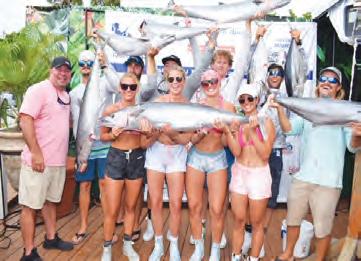
the tournament rules, and party at an event that’s truly not to be missed, with an incredible silent auction, liquor toss, and a lot of fun, fishing banter!
Fishing is on Saturday, June 7th. Boats depart from Port Everglades, Hillsboro Inlet, Boca Raton Inlet, Boynton Inlet, and West Palm Beach Inlet, and lines in are at 7:00am. The ladies will weigh in their catches from 3:00pm-6:00pm at Alsdorf Park in Pompano Beach. Everyone is encouraged to come out and enjoy music and drinks as they root on the teams! On Sunday, June 8th at 12:00pm, the tournament festivities will conclude with an awards ceremony at Galuppi’s in Pompano Beach, celebrating the achievements of the female anglers.
Over the last 39 years, the Ladies Annual Fish-Off has contributed over $600,000 to its beneficiaries! The tournament started back in 1986 with just 10 anglers and has grown to see upwards of 50 boats and 200 anglers!
benefit from the discounted registration fee! The tournament week commences on June 5th, with the main kickoff party and captain’s meeting from 6:00pm – 9:00pm at Galuppi’s in Pompano Beach. This event is also free and open to the public. Fishing teams come together to finalize their registrations, go over
The tournament is run by an amazing group of volunteers, who are always looking for new people to help continue this extraordinary charitable event! And the Ladies Annual Fish-Off is still offering sponsorship opportunities for this event, in the way of both monetary donations and in-kind items to be bid on its auction. For more information on sponsorship opportunities, beneficiary organizations, and registration details, please visit www.ladiesfishoff.com or contact its President, Nicole Zapetis, at 954-933-7587.



•
Beginner
• Maintained at 72 Degrees











5




























































May is off to a roaring start, with plenty of exotic action in the two main areas I fish, Everglades and the Lake Ida chain. Right now, along Alligator Alley and at Holiday Park, you can go from catching a 25-pound bag of largemouth bass during the day to strictly targeting exotics and landing over 100 fish, representing nearly ten different species. Leave the live bait at home when fishing the Everglades this time of year— you’ll run out quickly, and it’s not necessary. These fish are aggressive and willing to hit a variety of artificial presentations.

The Lake Ida Chain had a slower-than-normal start to the year, but things are firing on all cylinders now. I’m currently finding all of my biggest peacock bass on Lake Ida, and I’ve been using live bait to target them. With more guides working the lake than ever, there’s noticeable pressure on the larger fish, especially when it comes to live bait. Your best bet is to catch your own bait and learn the best ways to keep them alive. While shiners can still produce, they are farm-raised and come from colder water, making them less hardy in South Florida’s 80°+ conditions. Locally caught threadfin shad tend to last longer and are far more effective in this environment.
As water temperatures rise into the mid-80s this month we’ll see the end of the bedding season and a strong return to post-spawn feeding activity. If you’d rather not catch or buy live bait, there are plenty of artificial options that work incredibly well for peacock bass. My personal favorite is the Shimano Zumverno 95SP jerkbait. It has been a consistent producer and offers great action. Other effective lures include small crankbaits and soft plastics, especially the Z-Man StreakZ, which has proven itself time and again when targeting peacocks in pressured areas.
Clown knifefish are also becoming more active with the warming trend. As the temperature climbs, you’ll notice more of these fish rolling and moving around to feed and find cooler pockets. They’re a blast to catch on both live bait and artificial lures. My go-to artificial setup for clown knife is a 5” Z-Man StreakZ rigged on a Texas Eye jig head, dragged slowly along the lake bottom—it’s a presentation that’s hard for them to ignore. Lastly, snakehead activity has picked up with the recent warm spells and intermittent rain. My top producers right now are topwater frogs by American Snakehead Customs and tungsten chatterbaits like the Z-Man EVO. The explosive strikes and fight these fish offer make them one of the most exciting targets in South Florida.







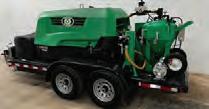











The month of May brings some thrilling fishing adventures, and it’s the perfect time to get out on the water! With warming temps and active fish, anglers are in for a treat. One of the biggest highlights is the opening of grouper season on May 1st—an exciting time to be aboard the drift boat.
This month, the drift boat is a top choice for those looking to reel in a variety of bottom-dwelling species. Expect steady action with snapper species, grunts, porgies, grouper, and plenty of other reef fish making their appearance. It’s an ideal trip for anglers of all skill levels and ages looking for nonstop bites and an overall great time.
If you’re after bigger game, sportfishing is where the real adventure begins. May is prime time for mahi mahi, which are often found in strong numbers offshore. The action doesn’t stop there—big game sharks, tuna, amberjacks, and trophy-sized grouper are also in the mix, offering a thrilling challenge for those who want to test their skills and strength.
Whether you’re bottom fishing on the drift boat or chasing pelagic predators on a sportfishing trip, May is packed with opportunity.
Give us a call or visit our website to book your fun-filled fishing adventure today!

lamingo, Everglades National Park, is a world-class fishery, and anglers Steve Herndon and Orjan Johansson recently proved why. They took a trip deep into the park, working the shallow flats where snook were stacked up and ready to eat. Using light tackle and precise casts, they found fish aggressively ambushing bait. Every drift produced fish, keeping the rods bent all day.
The trip to Flamingo is an adventure in itself. The drive from the park entrance to Flamingo takes you through miles of pristine Everglades, you might spot gators sunning along the roadside, wading birds hunting in the sawgrass, and the occasional deer crossing the road. Once you arrive, the Flamingo Lodge offers a great place to stay overnight, making it easy to get an early start.
In May the fishing is only going to get better. As water temps rise, snook, redfish, and even tarpon will flood the flats and backcountry creeks, feeding heavily. The baitfish hatch will bring life to the shallows, and the topwater bite will be electric at sunrise. Outgoing tides will have fish staged along points and creek mouths, making for prime conditions. Whether you’re sight-fishing snook in the mangroves or chasing rolling tarpon at first light, Flamingo is the place to be.
We cater to all anglers, whether you prefer spin reels or a fly-fishing experience. Live bait and artificial lures, depending on conditions and personal preference. If you’re looking for an unforgettable day on the water, now’s the time to start planning your next trip.
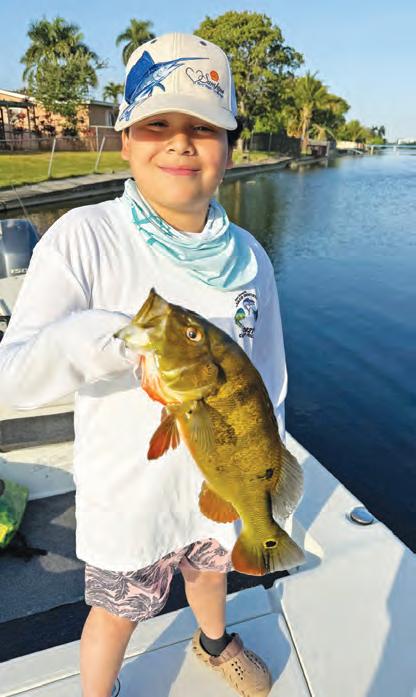
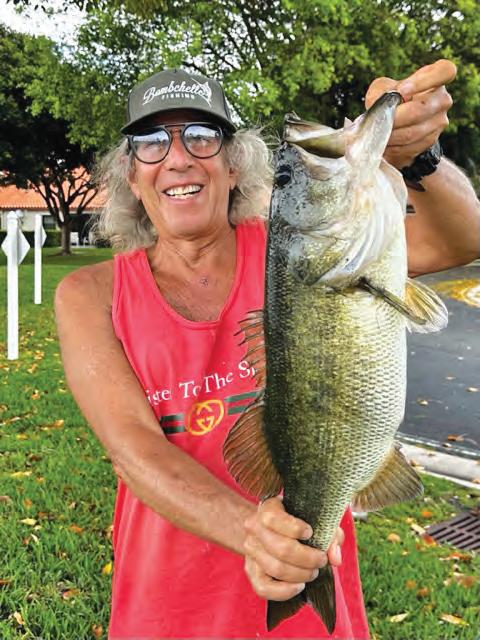
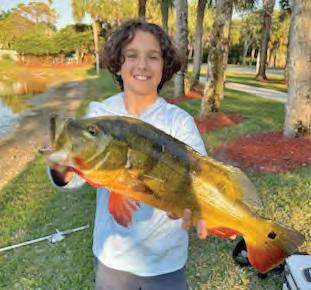




May 9th & 10th, 2025
Online Registration: MothersDayDolphinTournament.com
Captain’s Meeting
Liechty Marine
Friday May 9th - 6pm to 7pm
Lines In: Saturday, May 10 - 7:30am
Lines Out: Saturday, May 10 - 3:30pm
Weigh-In
Curly’s Co ee
Saturday, May 10th - 3:30pm to 6pm
Awards Banquet
Marathon Yacht Club
Saturday, May 10th - 7pm
Sunday Honor












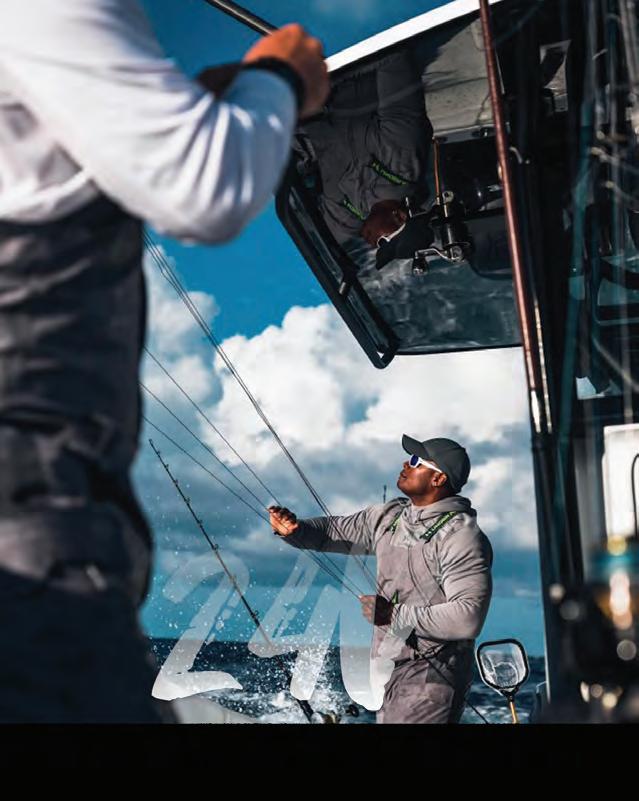







Brevard County, Florida, proudly holds the title of the loggerhead sea turtle capital of our hemisphere. Here, loggerhead nesting occurs so frequently that nests o!en go unmarked on some beaches. From April through the summer months, during nearly any full moon high tide at night, you might witness this natural phenomenon. However, it’s important to keep ashlights o and avoid ash photography to protect these vulnerable creatures.
Daytime nesting is rare for all turtles, making the sight of an endangered leatherback (the world’s largest sea turtle species) even more exceptional.

$is unique event was captured during the evening twilight hours at 6:30 p.m. Monday, April 7, in Satellite Beach, FL. $e Sea Turtle Preservation Society and UCF were on the scene.
Watch the video in this month's Angler Video Mag at vidmag.com and on coastalanglermag.com.
By Ryan Clapper

Headwaters Lake (Fellsmere Reservoir) is a 10,000-acre manmade lake located in Indian River County, adjacent to Stick Marsh/Farm 13. In the early 20th century, this area was drained for agriculture. In 2015, the St. Johns River Water Management District (SJRWMD) purchased the land and began ooding it to aid in ood control and nutrient removal for the Upper St. Johns River Basin. Before ooding, the Florida Fish and Wildlife Conservation Commission (FWC) and SJRWMD collaborated on extensive habitat and %sheries restoration projects to enhance %sh and wildlife habitats and create a premier %shing destination. Between 2011 and 2014, FWC invested $1.35 million in habitat enhancements at Headwaters, including shaping the lakebed with varied elevations such as holes, trenches, drop-o s, humps, and islands.
Following the ooding in 2016, FWC stocked the lake with 1 million Florida bass %ngerlings, 145,000 black crappie, 374,000 redear sun%sh, and 345,000 bluegill to rapidly establish a thriving sport%sh population.


On August 10, 2020, the Headwaters Lake boat ramp opened for the %rst time and the access facility was built in cooperation between the SJRWMD and FWC’s Boating Improvement Fund, which is supported by Sport%sh Restoration Funding. Since the opening of the boat ramp, the FWC has monitored angling e ort, catch, and angler success.
From 2020-2024, Fellsmere has averaged about 160,000+ angling hours annually and a bass catch rate of 1.40 bass per hour (one of the highest in the state). Furthermore, people from all over the country have traveled to %sh Fellsmere for its worldclass %shing opportunities. Fellsmere started generating TrophyCatch submissions of




bass 8 pounds and larger in 2017/2018 and since then has seen over 400 TrophyCatch submissions including two Hall of Fame catches weighing 13+ pounds.
For more information, visit myfwc.com.
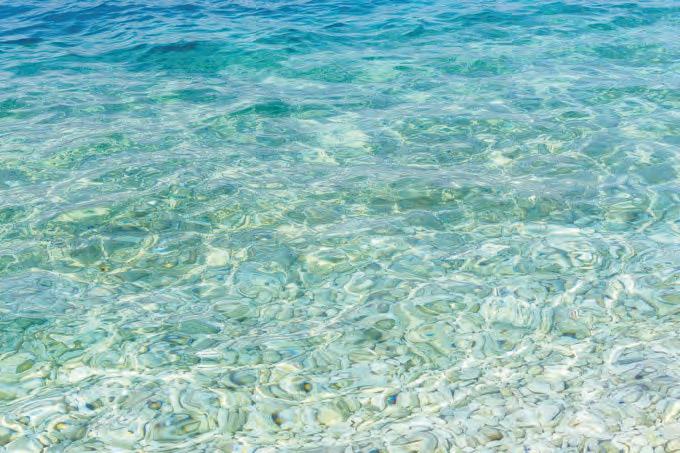



















By Ben Martin, Editor in Chief

Ikeep asking the question but can’t seem to get a clear answer on why Florida is not dedicating more resources to stocking red!sh and snook into our waters. e technology and infrastructure is there, but no one’s doing anything to bring about a robust restocking program to our state. Why the hell not? I don’t get it. We’re the number one !shing market in the U.S. and tourism fuels a state’s economy. However, according to the !ne folks who issue our !shing limits and restrictions, both species are “so depleted that we need to have severe catch limits and massive closures.”
Come on Florida government, put two plus two together. I think I speak for the majority of the Florida angling community when I say we’re just about disgusted with the ever-evolving limit and closure restrictions that have been coming our way for the past twenty years. It’s like there’s a group of people who just sit around and come up with more ways to infuriate the angling community in the name of conservation and some kind of “sustainability” mantra.
Just raise more !sh, idiots! Raise ’em like crazy. Get jiggy with it. Use my tax dollars the way I want you to use them. Stop spending my tax dollars on massive sta ng of non-anglers in positions of authority when it comes to my rules for !shing. Put enough red!sh and snook in our waters so that any kid can catch one. Yeah, I’m not the smartest person in the world, but I know when something is _______ (you know the rest).
Change your thinking or !nd a new job is what I’m talking about. Your trend over the last twenty years has been nothing short of adversarial, and I’m sick of paying your salaries just to anger our angling community. What !shing contributes to the Florida economy is nothing short of astronomical, but the allocation of resources to support it has been ass backwards for quite a while.
Here’s a good example of the mentality that I think dominates our marine o ces. I was wade !shing recently and as a car drove by on the nearby causeway a person stuck their head out of the window and screamed, “MURDERER!”
Yeah, that who’s been calling the shots for the angling community in Florida for the past twenty years and I, for one, am done with that prevailing mentality in the use of my tax dollars. Agree? Disagree? Fill out the form at protectourwaters.com.

Ben Martin Editor in Chief
Coastal Angler Magazine e Angler Magazine
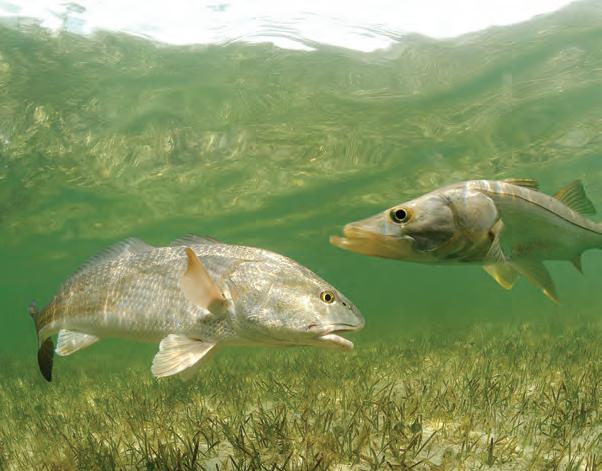
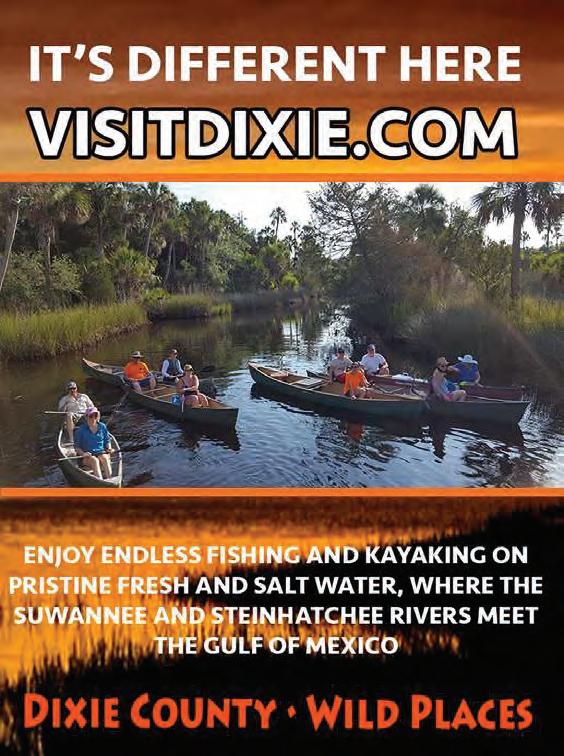

The International Game Fish Association (IGFA) has long been a global leader in promoting ethical angling practices, game %sh conservation, and angler education. One of its most accessible resources is the Intro to Fishing course, a structured educational program developed by the IGFA to provide a comprehensive introduction to recreational %shing in an online setting. $is engaging and interactive course is accessible to anyone with an internet connection and equips participants with basic skills, fostering a deep appreciation for the sport.
Targeted at youth, families, and beginner anglers, the course covers various aspects of %shing, including:
• The Fish: Understanding what a %sh is and how to identify various game %sh
• The Habitat: Learn where %sh live and di erent aquatic environments
• The Basics: Learning various %shing techniques from basic tackle to casting methods
• The Ethical Angler: Emphasizing responsible %shing practices, catch-and-release techniques, and habitat protection

43 acres (+or-) 1100 feet (+or-) on Suwannee River in Lafayette County at US 27, across river from Branford. Heavily wooded, perfect for residence, camp ground or hunting lodge. Elec. and well.
• The IGFA: Introducing students to the IGFA $e IGFA’s Intro to Fishing course launched in 2019 as a means to o er a comprehensive curriculum covering angling basics and safety, aquatic and marine biology, %sh identi%cation, environmental stewardship and more to audiences around the world. Packed with educational presentations, how-to videos, and interactive quizzes, the course allows anglers to follow along at their own pace. To date, nearly 1,200 students have completed the course, ranging from IGFA smallfry anglers aged up to 10 years old to experienced adult anglers. Most students are from North America, speci%cally from 43 states across the USA, but students from 35 di erent countries on six continents have completed it as well. While most students who have completed the course have caught a %sh before, nearly 15% of students have

43 acres (+or-) 1100 feet (+or-) on Suwannee River in Lafayette County at US 27, across river from Branford. Heavily wooded, perfect for residence, camp ground or hunting lodge. Elec. and well.



Cary A. Crutchfield
Registered Real Estate Broker GRI and CRS Designations

recorded that they have never caught a %sh before taking the course, but it has helped inspire these students to get outside and go %shing.
“Being new to %shing, it sparked my interest to start to %sh the most I can,” said Landon M., an IGFA Junior angler aged 11-16 years old from Hawaii, USA, who %nished the course in 2022.
Many schools from primary to college have utilized IGFA’s Intro to Fishing online resource as part of their course curriculum as well. Evan F., a college student from Kentucky, U.S. back in 2020 when he completed the course, recently had this to say in a post-student survey asking how the Intro to Fishing course has impacted their angling career since taking the course, “I took this class in correspondence with a freshwater %shing class in college. It has helped me have a better understanding and what to do when %shing and given me practices I still use to this day.”
For more information about the course and how to participate, visit igfa.org/learning-modules/.




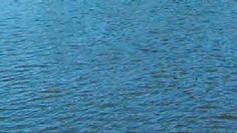











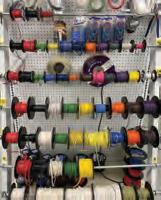
















The 2025 CCA Florida STAR competition presented by Yamaha continues to be Florida’s the largest family-friendly saltwater %shing competition. Running Saturday of Memorial Day weekend through Labor Day it boasts prizes & scholarships over $500,000 for anglers of all ages and skill levels.
$is year they’ve added the new Drum Spots “Lots-A-Spots” Division presented by Gulf States Automation. Red%sh with the most spots will win a share of $25,000 in prizes.

STAR’s signature Tagged Red%sh Division presented by TH Marine o ers %ve winners the choice of a Carolina Ski , Sea Born, Spyder Boat or Micro Dra! Ski , all powered by Yamaha. Two youth winners would win Carolina Ski 16-foot tiller boats powered by Yamaha, trailer, Minn Kota trolling motor and Humminbird electronics.
Each Florida coastal counties will have on average 4 green tagged red%sh released in their waters for a total of 167 prize winning tagged red%sh. Citrus and Charlotte Counties are Destination Counties with 8 tagged red%sh in their coastal waters.
$e Tigress Tagged Dolphin Division o ers a $10,000 cash prize for the %rst tagged dolphin landed.
$e Custom Gheenoe Inshore Division presented by Minn Kota and the Engel Coolers O shore Division presented by AFTCO allows 3 catch entries per day of competition and pays out 12 places with $60,000 in prizes in each.
You don’t have to catch a %sh to win a boat! Register before May 24th for one ra&e entry in the Triple Header Boat Ra&e. A Dek Kat 27 Trilogy, Spyder FX19 Vapor and a Carolina Ski 16JLS all powered by Yamaha will be given away on September 4, 2025.
$e Native Watercra! Kayak Division, Realtree Fishing Youth Scholarship Division, Power Pole Conservation Division and Costa Kick Plastic Trash Division o er amazing prizes too! ALL salt water species can be entered and most winners are determined by random drawing. Pick up the STAR Identi%er a!er May 17 at any West Marine store or distribution location.
Registration is $80 which includes CCA Florida membership. Kids ages 6-17 can register for free with current ($10) CCA Florida youth membership.
For more information on STAR, or to register, visit cca star.com
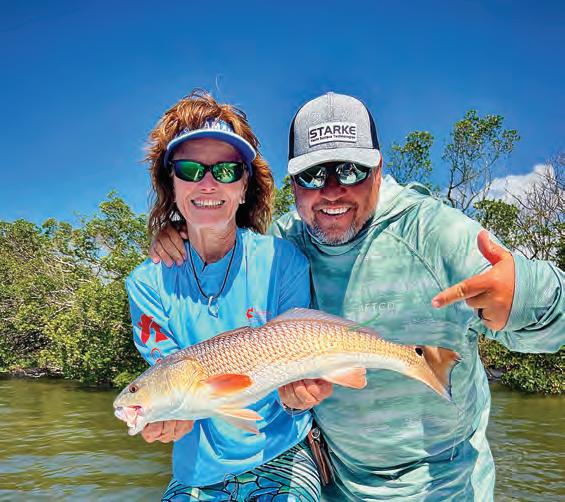
CTim Barefoot

an you say hallelujah? HALLELUJAH!!! $e powers that be say we can %nally catch and retain grouper as the season opens back up May 1. Decades ago, I never thought I would have said “grouper” and “season” in the same sentence, much less enduring this nine- or 10-months out of the year closure we’re experiencing now.
We recently took a recon trip to the edge to catch African pompano, but caught everything but African. $e barracudas and sharks are in numbers never seen before (by myself and a LOT of my friends), along with the American red snapper (ARS) and gag grouper. For anyone doubting the American red snapper and/or gag grouper numbers, please speak up now...or please come %shing with me!
We decided to leave the shark- and barracuda-infested deep water to catch some legal dinner %sh like grunts and seabass. We came inside a good ways and stopped on a pretty piece of bottom and it was nothing but gag, scamps and ARS bites. BAM! BAM! BAM!

Rolled back in another 10 miles knowing we were going to catch some seabass and grunts…and got nothing but gag and ARS bites. A!er that, we decided to go another eight miles inside speci%cally for sea bass, %nding traditional sea bass numbers. Fishing around in that general area, we ran out of all frozen cigar minnows and cut Spanish mackerel chunks before we could catch a good limit of sea bass.
I said all that to say this: %sh the pretty bottom marks of bait and structure using the correct tactics and you will have a heavy box of good %sh at the end of the day.
All the best %shing...
For more info, check out Tim Barefoot’s YouTube channel and website, barefootcatsandtackle.com.
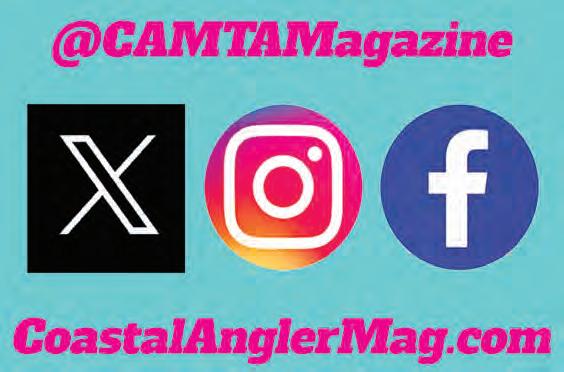





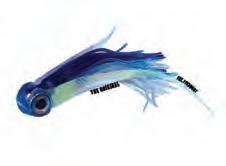


A!er breaking shermen’s hearts by releasing trophy grouper throughout the closed season, May is nally here, opening grouper season for anglers on the Atlantic Coast. I, for one, am thrilled to be able to add these tasty critters to the icebox yet again.
e red grouper is one of the most popular bottom sh found along the southeastern coast of the United States, particularly in the Gulf of Mexico and the Atlantic Ocean. It’s rm, white esh and rich avor make it a favorite for the majority of o%shore anglers. Easily recognizable by its reddish-brown coloration, the red grouper features scattered white blotches and a stocky body that suits its role as an ambush predator in rocky reef environments. Pulling one up from the depts that they exist in is the price you’ll pay to put this meat on your table because they’re also able to aggressively resist your will and challenge your strength. I like targeting them using live or cut bait. Once hooked, they tend to dive back into structure, which makes landing them a rewardingly brutal experience.
those who regularly bottom sh the overabundance seems to be more of a problem than the reduced stock assessments that NOAA has promoted.


e National Oceanic and Atmospheric Administration (NOAA), has attempted to monitor stock assessments of red grouper, although many cite awed data in their forecasts. e catch limits and season closures that they’ve implemented have substantially reduced the angling communities’ opportunities to catch this highly sought a!er sh. For

I could be wrong, but it seems as if NOAA has become antirecreation-fishing oriented. eir policies and choice of data has created a distrust among many (most all) anglers these days. While ASA and numerous other angler organization have attempted to impact NOAA’s trend toward “Don’t Catch,” much remains to be done to correct the adversarial relationship between the American angler and this once highly respected organization. My small home town once had an animal control o cer that hated and abused stray dogs. Once the community brought this to the attention of local government o ce the problem got solved relatively quickly. ey red him. No more problem. Has it come time to re the management team of NOAA?
Disclaimer: e views and opinions expressed in this column are those of the writer and do not necessarily re ect the views or positions of Coastal Angler Magazine or any entities they represent.


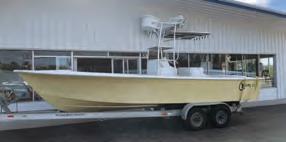












By Paul MacInnis
Catching channel cat sh can be a lot of fun and super rewarding—these guys ght hard! And the nice thing about cat shing is you don’t need fancy baits or tackle. If you want to target bullheads and smaller pan-sized cat sh you can use baits you gather right out of the river like grass shrimp and mussels. You can also use earth worms or small chunks of hotdog. Fish these baits on a 1/0 Aberdeen hook and add just enough split shot to your line to hold bottom.
But I prefer to target bigger channel cat sh, the bigger the better, using peeled shrimp for bait. You don’t need fresh shrimp, a bag of frozen shrimp from your local bait shop works ne. I also like to use cut bait as it holds up well to the bait stealers. Cut mullet or chunks from just about any sh work.
I use a standard sh nder rig. Run the line through a one-quarter to one ounce egg sinker, choosing just enough weight to hold bottom. Tie the line to a swivel and add about one to two feet of twenty pound test mono lament to the other end of the swivel. To the end of this leader I tie a 4/0 Team Cat sh TC84Z circle hook.
Baitcasting gear used for bass shing and 2000 to 3000 sized spinning tackle works ne for channel cats. You can get by with inexpensive mono lament, but I prefer a good quality 10-pound test braid like Platypus Platinum Plus. Braid won’t bow out as much as mono lament due to wind or current so it gives you a straighter connection between rod tip and bait. is kind of tackle can get sporty if a 10-pound-plus cat sh takes your bait, but sporty is exactly what I am looking for!






Popular wisdom says you should sh your baits in the deeper bends and holes. I shed that way for years and caught plenty of one to ve pound cat sh, but bigger sh eluded me. Many rivers (even lakes) are loaded with little coves and basins. I’ve learned if there is three feet or more of water in these basins there’s a decent chance there will be some nice cat sh there. I’ll park my kayak at the edge of the opening and cast a bait towards the center of the mouth of the cove, trying to place my bait in the slack water but close, within 10 feet or so, of the current. If I am feeling ambitious I’ll toss a second bait towards the back of the cove. Most of the time the biggest cat sh go for the bait close to the cove mouth...but that isn’t always the case. I like to let the circle hook do all the work so I’ll leave the rods in the rod holders until a sh puts a good bend in the rod and maybe even takes drag. Keep your ears open for loud splashes as channel cats will o!en thrash at the surface right a!er feeling the hook. Also watch your line. Cat sh don’t always take the bait going away from you. If your line goes slack or your bait changes position reel up tight and see if there is a sh on the line. Finally, if you start catching a lot of bow n you might want to move elsewhere (unless you like catching bow n) because I nd cat sh and bow n seldom share the same locations.
Channel cat sh can be aggressive predators and many a bass angler has been surprised when a big cat grabs their bass lure. Most of the time I wouldn’t advise tossing lures as an e cient way of targeting cat sh, but some years there is an exception that happens in spring into early summer. Winter and spring are typically dry season and water levels drop. Fish congregate in what deeper holes are le! and become aggressive due to high competition for food. is is one time when you can readily catch cat sh on lures and even ies. I like small plastic worms and other so! plastic baits bumped slowly along the bottom. Keep in mind cat sh are primarily scent feeders so dousing your lure with a decent sh scent helps.
During low water you’ll occasionally run across a real treat, a sandy bottom pool where you can spot cat sh and sight cast to them. I highly recommend a quality pair of polarized sunglasses with an amber tint and mirror coating to help you tell cat sh from gar and tilapia.
I suggest you give shing for channel cats a try, especially on those days when “game sh” don’t cooperate. Be patient, stay persistent, and enjoy the process!
When you rst drop your boat in the water, o!entimes it can be extremely overwhelming on where to sh and what to throw. One bait I have found in particular seems to catch bass at every lake I go to. is bait is a bladed jig, better known as a chatterbait. e bladed jig is a extremely versatile bait, meaning you can throw it around so many di%erent types of cover and sh it at many varying depths. It allows you to cover a vast amount of water and locate bass that would usually take days to nd with other baits.
As you approach a new lake or even one you have been to a thousand times, it’s always a good idea to throw a con dence bait that you know will get bites. e chatter-bait is mine. I’ve found that no matter the cover, grass, trees, docks, riprap, etc., it gets bit. With the blade on the front vibrating so erratically, it allows this bait to come through cover extremely well and creates a reaction strike no other bait can.
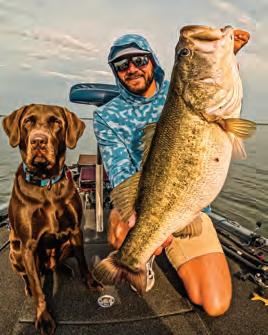
their home. Depending on the time of year and what kind of bait the bass are feeding on where you are shing, there is a color made to match the hatch. If shad is the prevalent forage, I like to stick to a white or a bait sh color like a pearl and silver with a silver colored blade. If it’s bluegill, you can get by with a green pumpkin or anything with some yellow and orange mixed in with a darker blade color. Sometimes water color can play a factor in color choice as well. If the water is very dirty, you will have to use a color that will stick out so that they can see it pass by. Something like a white and chartreuse with a white blade (for bait sh imitation) or even a bright orange with a black blade (for craw sh imitation) can do the trick.
TYLER WOOLCOTT

Buying a bladed jig and tying it directly on your rod usually isn’t too e%ective without putting a trailer on the back of it. I like to try and match the color of the trailer to the color of the skirt on your chatterbait of choice to get the most natural look for the sh. e type of trailer can be a bit more complicated. I use either a swimbait style trailer with a boot tail or a apping style trailer like a craw pattern. e boot tail stands out when sh are very aggressive and aren’t scared of the more aggressive action the boot tail causes behind the bait. e appy trailer is better for highly-pressured sh that want a little more of a subtle approach who might not like the amount of action a swimbait trailer has.
A chatterbait is a very dominant bait all across the country and I rely on this bait at all times of the year to help me put sh in the boat. Next time you hit the lake, give the chatter-baitt a try and cover some water!
Let’s talk about matching the chatterbait to the bait forage. By matching the color of the bladed jig to the forage in the lake, a bass can’t resist it as a nice snack when you reel it through
Sizes and weights of your bladed jig are extremely important. With sizes ranging from 1/4 oz. all the way to 1.25 oz., the depth you are shing will decide what you tie on. I typically start with a 3/8 oz. or a 1/2 oz. which will allow you to cover water depths from 1 to 10 feet depending on your retrieve. If I nd some deeper cover that i want to get down to and sh, I will go a little heavier to a 3/4 oz.

Whether you’re fishing in a kayak, canoe, or small boat, the ePropulsion eLite 500W redefines your on-water experience with innovative features and commitment to sustainability. Designed to be the most compact and lightweight electric outboard in its class, it is an easy-to-use alternative to small internal combustion engines for enthusiasts worldwide. Max 5.6 miles at half throttle and 3.5 miles at full throttle.
BLADED JIG GEAR: When throwing a bladed jig its important to have the correct gear. I use a 13 Fishing Myth Rod 7’5 MH-mod paired with a 13 Fishing Concept A 7:5:1 reel. I spool this up with 17 lb. Su x Advance Fluorocarbon line making this the perfect combo for the job.
Tyler Woolcott is a professional tournament angler and guide. Check out his website at www.tylerwoolcott shing.com.






— Gene H.

Switzerland is synonymous with expensive, big-name luxury watches like Rolex®, Piaget® and Patek Philippe® that sell for thousands, but the Stauer Swiss Tactical Watch delivers Swiss precision for a fraction of the cost. Inspired by military timepieces like the American A-11, it combines rugged performance, simplicity, and legendary craftsmanship — built for action, not display cases.
Precision Takes Time
Swiss excellence demands patience. Each Stauer Swiss Tactical takes nearly nine months to complete, and this is a limited edition of 4,900. Crafted by master watchmakers, some of whom have worked with the other prestigious brands, this is your chance to own a rare, precision-engineered tactical watch without the inflated luxury price tag.
Why Pay for a Name?
Big brands charge more for status. Stauer delivers the same quality and precision with high-contrast markers for instant readability, a shock-resistant case to withstand hard knocks and Swiss-made movement for impeccable timing.
Limited Offer – Act Now
Don’t miss this rare combination of Swiss craftsmanship and unbeatable value. Only 4,900 available — once they’re gone, they’re gone.
Why pay more when you can own precision, heritage, and adventure for less? Order now — time is running out.
Watch Speci cations:
• Made in Switzerland with precision Swiss Ronda 515 movement. Stainless steel caseback. Brown leather band
• 44 mm diameter case. Date window at 3 o’clock
• Water-resistant to 3 ATM. Fits wrists up to 8 ¼”
Stauer Swiss Tactical Watch
$399 $59* + S & P Save $340
*Special price only for
APort Arthur, TX angler and his friends recently achieved an extraordinary feat— reeling in an enormous 884-pound blue n tuna.
On April 10, David Esslinger and his friends were shing in the Gulf when the massive sh struck his line with incredible force. He had no idea he was about to embark on the most intense battle of his shing career. ankfully, Esslinger had an eager crew by his side, ready to assist in landing this remarkable sh.
“Let me break down the day and the events for you. First o%, for those who have never landed a sh the size of a car, this is no small feat. No one accomplishes this alone,” Esslinger posted on Facebook.
e group set out early Friday morning. By 9 a.m., a!er a couple of hours of shing, they started noticing signs of a school of tuna breaking the surface of the calm waters. Suddenly, the right rigger snapped down with a forceful bite, signaling the start of Esslinger’s showdown against his monstrous tuna.
Esslinger recalls, “Big tuna started breaking the surface and our team’s spirits began to li! at’s when it happened—the right rigger came down hard. e sh ran about ten seconds and spit the 12/0 mustad hook and the bait. As my heart sank,
I came up on the drag and gave her 10 cranks. As soon as I engaged the clicker again the giant sh piled on again. at’s when the rst 3/4 spool run at 35 pounds of drag started.”
Realizing what was at stake, his team quickly got into position for the ensuing battle, clearing lines and the deck.
“I had to crank it up to 45 pounds of drag on the Tiagra to slow her down. She responded with a rush to the surface. Carson was at the helm with Brad, TC, Je%, and Colby, coordinating everything e ciently from cockpit to helm. We managed to get the sh up to the surface in just over an hour,” stated Esslinger.
A!er an exhausting ve-hour battle of strength and endurance, Esslinger and his crew nally brought the massive blue n alongside the boat. With shaking body and inoperable hands, Esslinger made his way to the side of the boat and screamed with utter shock, “What a giant blue n! We did it!”
is impressive catch is seen as a trophy sh among anglers, celebrated for its enormous size and high-quality meat. And it was indeed enormous. Weighing in at 884 pounds, this blue n tuna has set a new state record for the largest tuna caught in Texas, surpassing the previous record of 876 pounds established by Troy Lancaster in 2021.



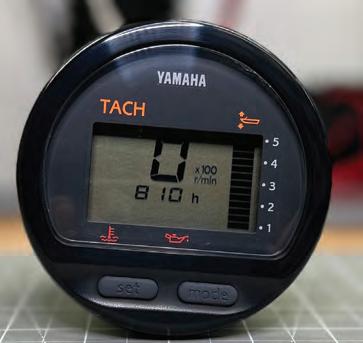
By CAM Sta







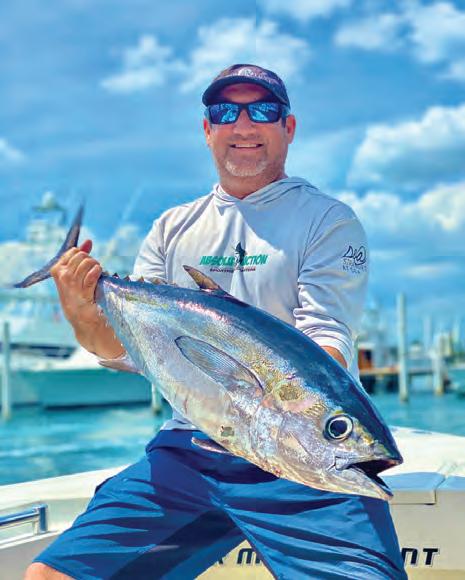






You want AI Routing! Let TZ MAPS with AI Routing make route planning a snap. Don’t take our word for it. Scan here to see for yourself how easy it is!